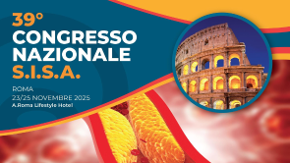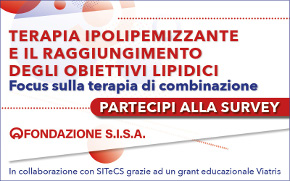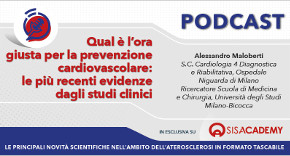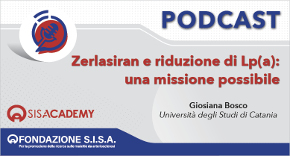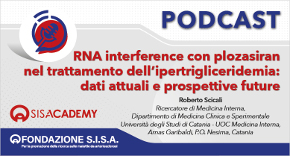 Rivista in lingua italiana
Rivista in lingua italiana
riservata ai Soci SISA
Ultimo numero:
Anno 16 • N.1/2025
SISANews
Una variante genetica comune predice la gravità della malattia coronarica
Non c'è il minimo dubbio che la malattia coronarica derivi da una complessa interazione tra fattori genetici e fattori ambientali. Non a caso tra i fattori di rischio per la cardiopatia ischemica viene da sempre annoverata la familiarità definita in maniera probabilmente non corretta, ma clinicamente utile, come l'occorrenza di eventi ischemici in età precoce nella famiglia. Nonostante l'impegno crescente nella ricerca genetica, grandi progressi non ne sono stati fatti e le basi su cui poggia la componente genetica del rischio cardiovascolare rimangono ancora oscure, con l'eccezione di quelle che si manifestano con un fenotipo dismetabolico. Una promessa per un chiarimento è stata fornita dalla scoperta di un locus al cromosoma 9p21.3 che in numerose ricerche è sempre risultato associato alla cardiopatia ischemica. La variante 9p21 è piuttosto comune (circa il 50% dei soggetti è portatore di un allele ad alto rischio che conferisce un aumento della probabilità di cardiopatia del 20-40%) e in questo nuovo studio ha dimostrato una forte associazione con la gravità delle lesioni coronariche. Anche se non è chiaro con quale meccanismo, è verosimile che tale anomalia genetica sia implicata già nelle prime fasi del processo aterogenetico.
![]()
Gene dosage of the common variant 9p21 predicts severity of coronary artery disease
Dandona S, Stewart AF, Chen L, Williams K, So D, O'Brien E, Glover C, Lemay M, Assogba O, Vo L, Wang YQ, Labinaz M, Wells GA, McPherson R, Roberts R.
J Am Coll Cardiol 2010;56:479-86
OBJECTIVES: The purpose of this study was to test the hypothesis that 9p21 gene dosage determines the severity of coronary artery disease (CAD).
BACKGROUND: The 9p21 locus is the first common genetic variant to associate with risk of CAD and/or myocardial infarction in multiple studies.
METHODS: A cross-sectional study examined nondiabetic patients with CAD defined by coronary angiography to have at least 1 epicardial stenosis >50%. In all, 950 patients with early onset CAD (age 56.1 +/- 9.6 years) and an independent sample of 764 patients with late onset CAD (age 70.0 +/- 8.0 years) were enrolled from the cardiac catheterization laboratories at the University of Ottawa Heart Institute from April 15, 2006, to August 15, 2008, and genotyped for the single nucleotide polymorphism rs1333049 9p21 risk variant. Angiographers were blinded to genotype. The association between 9p21 risk genotype and the proportion of patients with 3-vessel disease, 1-vessel disease, left main trunk disease, and coronary artery bypass graft surgery was tested, as was its association with the modified Gensini and Duke coronary scoring indexes.
RESULTS: Among younger CAD cases, 3-vessel disease demonstrated a strong, direct association with 9p21 gene dosage (p = 4.26 x 10(-4)). Conversely, 1-vessel disease demonstrated a strong inverse association with increasing gene dosage (p = 2.41 x 10(-5)). In the replication sample, gene dosage also predicted 3-vessel disease (p = 6.51 x 10(-6)). Left main trunk disease and coronary artery bypass graft surgery demonstrated a direct strong association with gene dosage (p = 3.66 x 10(-4)) and (p = 2.42 x 10(-2)), respectively. Gene dosage demonstrated a strong, direct association with both the modified Gensini (p < 0.0001) and modified Duke (p = 3 x 10(-4)) coronary scores. Risk variant 9p21 did not associate with myocardial infarction once stratified for disease severity.
CONCLUSIONS: Gene dosage of the common risk variant 9p21 predicts the severity of coronary atheromatous burden.
J Am Coll Cardiol 2010;56:479-86

Area Soci
Eventi
39° Congresso Nazionale
 39° Congresso Nazionale
39° Congresso NazionaleRoma, 23-25 novembre 2025
Save the date




 Spring Meeting Gruppi Giovani SID, SIGG, SIIA, SIMI, SIPREC, SISA
Spring Meeting Gruppi Giovani SID, SIGG, SIIA, SIMI, SIPREC, SISARimini, 6-8 aprile 2025
[continua a leggere]
 SISA LIPID ACADEMY - Corso avanzato di lipidologia clinica
SISA LIPID ACADEMY - Corso avanzato di lipidologia clinicaModena, 4-5 Luglio 2024
[continua a leggere]Giornale Italiano Arteriosclerosi
HoFH today
 Rivista Italiana della
Rivista Italiana della
Ipercolesterolemia
Familiare Omozigote
Anno 6 • N.1/2024
Rivista NMCD
Diateca
[continua a leggere]
[continua a leggere]
Newsletter
il vostro indirizzo di posta elettronica
Progetto LIPIGEN
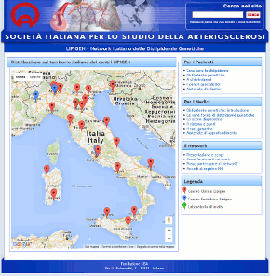
Nuovo sito dedicato al Progetto LIPIGEN
Progetto LIPIGEN - Vecchio portale
E' necessario essere loggati come utente
Lipigen per poter accedere alla pagina
PROject Statin Intolerance SISA
PROSISA – PROject Statin Intolerance SISA
E' necessario essere loggati come utente
PROSISA per poter accedere alla pagina
GILA - Lipoprotein Aferesi
Gruppo Interdisciplinare Lipoprotein Aferesi
(Accesso Gruppo GILA-Lipoprotein Aferesi)
E' necessario essere loggati come utente del Gruppo GILA per poter accedere
Gruppo Interdisciplinare Lipoprotein Aferesi
(Documentazione ad accesso libero)
Pagina informativa per medici e pazienti


